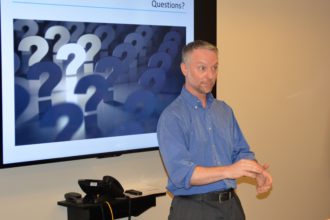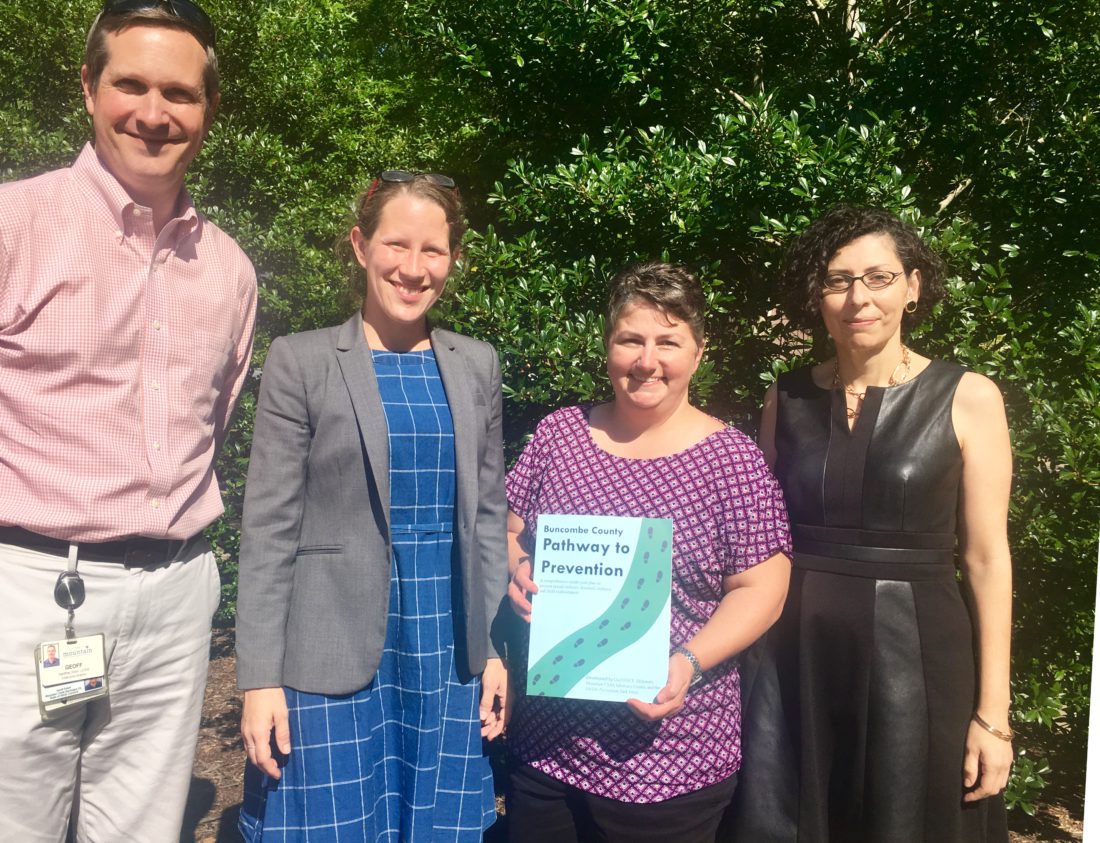When a woman is battered by a partner, it’s usually not an isolated incident. In fact, say advocates, she likely was mistreated as a child, and her abuser is often either a witness to or a survivor of violence.
“Violence doesn’t happen in a silo, so we shouldn’t treat its various manifestations as though they did,” says Angélica Wind, executive director of Our VOICE, a Buncombe County advocacy agency for people who have experienced sexual violence. “You can fund silos, or you can fund a coordinated effort.”
Our VOICE, Helpmate, Pisgah Legal Services and the Mountain Child Advocacy Center are jointly the recipients of this year’s Power of the Purse Grant from Women for Women. The grant, $450,000 to be distributed over three years, will allow the agencies to work with the community to find ways to address and prevent domestic violence, sexual violence and child maltreatment.
The grant, advocates say, provides critical resources to support the agencies in treating violence as a public health issue, much the way tobacco use and driving while drunk have been. The funders and the partner agencies believe public education on the causes and results of these types of violence likely will increase awareness and eventually decrease the incidence of violence in our community.
New approach
Funding across cooperating agencies is an emerging trend in grantmaking, says Tricia Wilson of Women for Women, a fund created and managed by women through the Community Foundation of Western North Carolina.
“People come individually with individual projects, but good things come from collaboration,” Wilson says. “Research from the [Centers for Disease Control and Prevention] shows a need for violence to be addressed across the spectrum like this.”
Buncombe County has begun to see the effects of a coordinated effort to address these three types of violence following a county-led initiative to combine services from several agencies at the Family Justice Center. The FJC allows people to obtain services at one central location at 35 Woodfin St. rather than having to schedule appointments all over town.
Before the FJC opened in August 2016, “People had to tell their stories again and again, which just re-traumatizes them,” says April Burgess-Johnson, executive director of Helpmate. “They had to go to several different agencies, and a lot of women who are experiencing domestic violence don’t have cars. It was a lot of effort.”
In it for the long haul
The plan for the grant-funded programming has been in development for three years, says Julia Horrocks, an attorney with Pisgah Legal Services, and, she adds, there is no quick fix.
“You have to change social norms,” she says. “Mothers Against Drunk Driving did it; it was done with tobacco. It takes a lot of effort. That’s why we’re addressing it on a community level. We’re not going to solve this in three years, but we can set up the structure that will.”
Helpmate, Our VOICE and the Mountain Child Advocacy Center will each receive $33,000 to underwrite prevention educators in each of the three years of the grant, which accounts for $297,000, or 66 percent, of the funding. Helpmate and Our VOICE will each receive an additional $45,000 over the three years to facilitate intake services at the FJC. And Pisgah Legal Services will draw $15,000 in each of the three years for public policy advocacy related to achieving the plan’s goals. The remaining $18,000 will fund partnerships with other community-based organizations.
The group’s report, Buncombe County Pathway to Prevention, details the scope of the problem and lays out a long-term plan aimed at “preventing perpetration of domestic violence, sexual assault and child maltreatment.”
The statistics the report cites are grim: In Buncombe County alone, one case of child maltreatment is reported every two hours, two people are raped every day and 50 survivors of domestic violence reach out to Helpmate each week.
Worth a pound of cure
To explain the complex way violence and abuse are perpetuated in the community, the report examines a profile of John, a hypothetical perpetrator of sexual assault and domestic violence based on real-life examples from Buncombe County, along with key experiences in John’s life that predisposed him to violence. The report then poses alternative scenarios that might have led him down a different path.
John was born to a teenage mother who left him in the care of an aunt. When John was 8, a neighbor molested him. In one scenario, John’s aunt and uncle rarely talk about emotions, and he is encouraged to “be a man” and be tough. He doesn’t tell his family about what happened because he believes showing emotions would be a sign of weakness.
In the other scenario, John’s aunt talks to him about ways to regulate his emotions — breathing slowly, expressing what he feels — and he knows he can talk to her about it. She gets him the help he needs.
On the baseball field, John’s coach admonishes him, “Don’t throw like a girl,” and tells him to stop “acting like a little bitch” when he cries after losing an important game. He swears he won’t allow anyone to accuse him of being weak again.
In the alternate scenario, the coach helps John deal with losses on the baseball field.
In college, John and other athletes on the baseball team attend a party and offer drinks to a girl who’s already visibly intoxicated. Things get out of hand; the girl later sees a video and files charges, but the athletes are let off with two hours of community service.
In the report’s parallel universe, John’s college requires all students to complete a service learning requirement. He takes part in a group that provides health education to other students. At the party, John intervenes to make sure the girl gets home safely with a friend and advocates for new sexual harassment policies for the team.
At several points in his childhood and adolescence, John’s experiences reinforced stereotypes that excuse aggressive behavior with phrases such as “boys will be boys.” As an athlete, he was able to get away with behaviors for which others face consequences.
In the alternate scenario, different responses and character traits were valued, supported and reinforced.
“This is why we need to reach people where they live, learn, work, play and worship,” Wind says. “We need to teach young people to resolve conflicts, to respect consent, how to develop and maintain healthy relationships.”
Early intervention
According to the plan, it’s also important to intervene early when risk factors are present, including:
- Low educational achievement;
- Lack of nonviolent problem-solving skills;
- Victims of or witnessed violence;
- Psychological issues;
- Low income;
- Poor parent-child relationships;
- Live in neighborhoods with violence, drugs and/or gangs;
- Experience sexism or racism.
Those who experience these circumstances are more likely to commit violence, the plan posits, because violence tends to be normalized under these conditions.
But there are protective factors, such as teaching nonviolent skills at the appropriate age, strong family connections, coordination among agencies that deal with families and other community supports and laws that promote the well-being of children and families.
Power of the plan
The plan detailed in “Pathways to Prevention” uses a model developed by the CDC. Beginning with individuals and expanding outward to encompass service providers, the broader community, coalitions, networks, organizational practices, policies and laws, the plan seeks to take a comprehensive approach to the problem.
Burgess-Johnson explains that prevention education, the activity that accounts for two-thirds of the funding, will teach “boundary setting, healthy relationship formation and nonviolent conflict resolution. We intend to work with schools, employers, faith groups and other key community influencers to help share information about these important skills.” Plan partners also will work with local and state policymakers to promote accountability for abusive behavior, she adds.
The grant partners have formed a task force to implement the plan. At its first meeting in August, more than 30 people from a dozen agencies met to form committees and discuss how to implement the plan.

Graham Hackett, prevention educator for Our VOICE, chairs the task force. “I sincerely believe we have the tools we need to end these types of violence in Buncombe County,” Hackett said as he opened the meeting. “We’re looking at this plan as something people can buy into and find a way to contribute.”
Pathway to Prevention notes some of the limitations of the plan. Designed with frequent cycles of assessment and review, the plan’s methodology allows significant opportunities for receiving input and refining activities, which the task force believes will take longer but strengthen the end result.
An increase in awareness and visibility of violence will likely trigger “an initial increase in reports of violence that typically happen behind closed doors,” the plan notes. Also, some causes of violence, such as poverty, racism and gentrification, the plan concedes, “are beyond the scope of any one plan, even a large cross-sector initiative like this.”
The plan won’t be complete when the three years of funding runs out, Wind says, but it will be in place and working toward the goal. “This isn’t a one-time thing,” Wind says. “This is setting up a permanent system that will help prevent these kinds of violence.”
For more information on the process and how you can help, or to obtain a copy of the report, contact Hackett at grahamH@ourvoicenc.org.



“Athletes let off with two hours of community service” for sexual assault on an intoxicated girl? And they videotaped it?
Who is dredging up these grossly cynical and dishonest hypotheticals? Did you, whoever you are, draw this foolishness from Steubenville or UVA? The boys in Steubenville went to prison, and the boys at UVA are the product of a phony victim’s sick imagination and a feminist writer’s rush to judgment and to tabloid the innocent, a la the Duke lacrosse athletes, at the RS magazine.
Where is the narrative which fed the hypothetical?